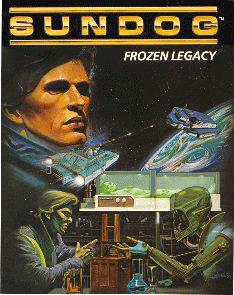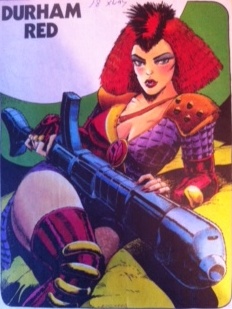
Area 51 is a light gun arcade game released by Time Warner Interactive in 1995. It takes its name from the military facility. The plot of the game involves the player taking part in a Strategic Tactical Advanced Alien Response (STAAR) military incursion to prevent aliens, known as the Kronn, and alien-created zombies from taking over the Area 51 military facility.

SunDog: Frozen Legacy is a 1984 space trading and combat simulator video game. SunDog was first developed for the Apple II, with version 1.0 being released in March 1984, and version 1.1 released three weeks later. Version 2.0, which included enhancements and improved performance, was released in October, 1984. An enhanced version was released for the Atari ST in December 1985.

Strontium Dog is a long-running British comics series starring Johnny Alpha, a mutant bounty hunter who lives in Earth's future. The series was created in 1978 by writer John Wagner and artist Carlos Ezquerra for Starlord, a short-lived weekly science fiction comic. When Starlord was cancelled, the series transferred to the British science fiction weekly 2000 AD. In 1980, Wagner was joined by co-writer Alan Grant, although scripts were normally credited to Grant alone. Grant wrote the series by himself from 1988 to 1990. Wagner revived the series after a ten-year hiatus in 2000. After Ezquerra's death in October 2018, the series was put in indefinite hiatus with no current plans for its continuation.

Sabre Wulf is an action-adventure game released by British video game developer Ultimate Play the Game for the ZX Spectrum home computer in 1984. The player navigates the pith-helmeted Sabreman through a 2D jungle maze while collecting amulet pieces to bypass the guardian at its exit. The player does not receive explicit guidance on how to play and is left to decipher the game's objectives through trial and error. Sabreman moves between the maze's 256 connected screens by touching the border where one screen ends and another begins. Each screen is filled with colourful flora, enemies that spawn at random, and occasional collectibles.

Alien 8 is an action-adventure video game developed and published by Ultimate Play the Game. It was released for the ZX Spectrum, BBC Micro, Amstrad CPC and MSX in 1985. The game is a spiritual successor to the best-selling Knight Lore, which was lauded by critics for its isometric graphics. In the game, the player takes control of a robot, Alien 8, whose job is to ensure that all of the cryogenically frozen passengers on board a starship remain viable during the ship's voyage.

Durham Red is a British comics character, originally created in 1987 as a female sidekick and lover for Johnny Alpha in the long-running comic book series Strontium Dog in 2000 AD. She is a bounty hunter with a mutation that gives her a vampiric lust for blood.

Bomberman is a maze video game developed and published by Hudson Soft. The original home computer game Bomber Man was released in July 1983 for the NEC PC-8801, NEC PC-6001 mkII, Fujitsu FM-7, Sharp MZ-700, Sharp MZ-2000, Sharp X1 and MSX in Japan, and a graphically modified version for the MSX and ZX Spectrum in Europe as Eric and the Floaters. A sequel, 3-D Bomberman, was produced. In 1985, Bomberman was released for the Nintendo Entertainment System. It spawned the Bomberman series with many installments building on its basic gameplay.

Eureka! is a video game for the Commodore 64 and ZX Spectrum computers, written by Ian Livingstone, developed by Novotrade for Andromeda Software and published by Domark in 1984.

Cauldron is a video game developed and published by British developer Palace Software in 1985 for the ZX Spectrum, Commodore 64, and Amstrad CPC home computers. It contains both platform game and horizontally scrolling shooter sections. Players control a witch who aims to become the "Witch Queen" by defeating an enemy called the "Pumpking".
Quicksilva was a British games software publisher active during the early 1980s.

Beach Head II: The Dictator Strikes Back is 1985 shoot 'em up video game for the Commodore 64, a sequel to Beach Head, developed and published by Access Software. It was designed by Bruce Carver and his brother, Roger, and was released for the Amstrad CPC, Apple II, Atari 8-bit computers, Commodore 64, and ZX Spectrum.

Android Two is a shoot 'em up maze video game written by Costa Panayi and published by Vortex Software in 1983 for the ZX Spectrum and in 1985 for the Amstrad CPC. It is the sequel to Android One: The Reactor Run, released earlier in 1983.

Blade Runner is a 1985 shoot 'em up game loosely inspired by the 1982 film Blade Runner. The game was published in 1985 by CRL Group PLC for Commodore 64, ZX Spectrum, and Amstrad CPC. Reviews of the game were mostly negative.

Moonlight Madness is a platform game for the ZX Spectrum home computer, published in 1986 by Bubble Bus Software. The player controls a boy scout attempting to unlock a safe within a mansion to obtain pills for the mansion's owner, a mad scientist, who has collapsed. This requires the player to traverse the mansion's rooms while avoiding hazards such as dangerous house servants and fatal falls.

Soft & Cuddly is a horror action-adventure game released for the ZX Spectrum home computer. It was developed by John George Jones and published by The Power House in September 1987 in the United Kingdom and in early 1988 in Spain. The player assumes the role of a man armed with a laser gun and a jet pack, whose mother, the Android Queen, has been dismembered. The player's task is to locate the scattered body parts of the Android Queen and sew her back together.

Mined-Out is a maze video game created by Ian Andrew originally for the ZX Spectrum home computer in 1983. The objective is to carefully navigate a series of grid-shaped minefields by moving from the bottom to the top of the screen. The number of invisible mines in spaces adjacent to the player's current position is shown but not their precise location, requiring deduction to advance past them and avoid getting blown up. Additional challenges are introduced in later stages.

Hans Kloss is a puzzle-platform game designed by Dariusz Żołna and published in Poland by LK Avalon. It was published in 1992 for Atari 8-bit computers. A Commodore 64 conversion, programmed by Janusz Dąbrowski, was released in 1993. The player controls Hans Kloss, the fictional protagonist of the Polish TV series Stawka większa niż życie, during World War II. He must find plans for a secret weapon in Adolf Hitler's headquarters, the Wolf's Lair.

Hero of the Golden Talisman is an action-adventure video game developed by British studio Mr Chip Software and published by Mastertronic in 1985 for the Commodore 64. A port to the Amstrad CPC followed. It is an early example of the Metroidvania style, despite preceding both of the genre's namesakes.

Judge Dredd is a platform shoot 'em up video game based on the character of the same name. It was developed by Beam Software and published by Melbourne House. It was released in Europe in 1986, for Commodore 64 and ZX Spectrum.

3D Tank Duel is a video game developed by Realtime Games Software for the ZX Spectrum home computer. It is a clone of the arcade game Battlezone, featuring wireframe 3D graphics with color.


















